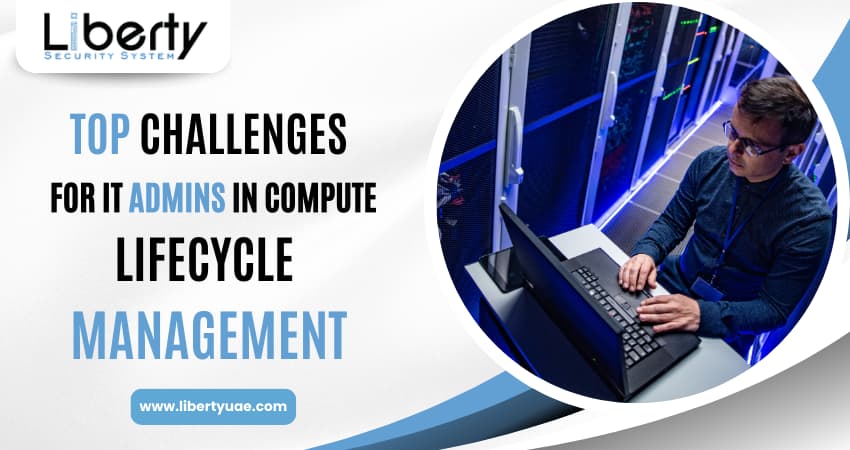IT managers face many difficulties when trying to manage the computing lifecycle efficiently. Every stage, from deployment and provisioning to security and scalability, has its own set of obstacles that must be carefully avoided.
We’ll examine the most common issues that IT administrators have with computing lifecycle management in this blog article, along with practical solutions.
Table of Contents
What is Compute Lifecycle Management?

Compute Lifecycle Management refers to the end-to-end process of managing computing resources throughout their entire lifecycle, from provisioning and deployment to maintenance, optimization, and retirement.
It encompasses various stages, including planning, acquisition, configuration, monitoring, and decommissioning, and involves tasks such as resource allocation, performance monitoring, security management, and capacity planning.
Compute Lifecycle Management aims to ensure the efficient and effective utilization of computing resources, optimize system performance, minimize downtime, and align IT infrastructure with business objectives.
Features Of Compute Lifecycle Management

Compute Lifecycle Management encompasses several key features to effectively manage computing resources throughout their lifecycle. Some of the prominent features include –
- Resource Provisioning – Compute Lifecycle Management involves provisioning computing resources such as servers, storage, and networking equipment to meet the needs of users and applications. This includes allocating resources based on demand, configuring hardware and software, and ensuring compatibility with existing infrastructure.
- Deployment Automation – Automation plays a crucial role in Compute Lifecycle Management by streamlining the deployment process for new computing resources. Automated deployment tools enable IT administrators to provision and configure systems rapidly, ensuring consistency and reducing the risk of errors.
- Performance Monitoring – Monitoring the performance of computing resources is essential for optimizing system functionality and identifying potential issues. Compute Lifecycle Management solutions include features for monitoring resource utilization, performance metrics, and system health in real-time, allowing IT administrators to proactively identify and address performance bottlenecks.
- Security Management – Security is a critical aspect of Compute Lifecycle Management, encompassing measures to protect computing resources from unauthorized access, data breaches, and cyber threats. Features such as access controls, encryption, authentication mechanisms, and vulnerability assessments help ensure the security and integrity of IT infrastructure.
- Scalability and Flexibility – Compute Lifecycle Management solutions provide scalability and flexibility to accommodate changing business requirements and workload demands. IT administrators can scale computing resources up or down dynamically, allocate resources based on demand, and adjust configurations to optimize performance and efficiency.
- Lifecycle Automation – Automating lifecycle processes such as provisioning, configuration, patch management, and decommissioning helps streamline operations and reduce manual effort. Lifecycle automation features enable IT administrators to automate repetitive tasks, enforce policy compliance, and ensure consistency across the infrastructure.
- Compliance Management – Compliance management features in Compute Lifecycle Management solutions help ensure adherence to regulatory requirements, industry standards, and organizational policies. IT administrators can implement compliance checks, audit trails, and reporting mechanisms to demonstrate compliance and mitigate risk.
- Cost Optimization – Cost optimization is a key feature of Compute Lifecycle Management, allowing organizations to maximize the value of their IT investments while minimizing expenses. Features such as resource optimization, capacity planning, and cost analysis help identify opportunities for cost savings and efficiency improvements.
Know The List Of Challenges For IT Admins in Compute Lifecycle Management:

- Resource Allocation and Optimization
Balancing compute resources such as CPU, memory, and storage across diverse workloads poses a significant challenge for IT admins. Optimizing resource allocation to meet varying demands while avoiding overprovisioning or underutilization requires meticulous planning and continuous monitoring.
IT administrators must assess workload requirements, prioritize resource allocation based on application criticality and performance objectives, and dynamically adjust resource allocations as workload demands fluctuate. This involves implementing resource management strategies such as workload scheduling, dynamic resource provisioning, and resource pooling to ensure efficient resource utilization and maximize ROI on infrastructure investments.
- Provisioning and Deployment
The rapid provisioning and deployment of new computing resources can be complex and time-consuming. Streamlining these processes through automation and standardization is essential for accelerating deployment cycles and maintaining consistency across the infrastructure. IT admins must leverage infrastructure as code (IaC) tools and configuration management platforms to automate provisioning workflows, define infrastructure templates, and enforce configuration policies.
By automating routine tasks such as server provisioning, software deployment, and configuration management, IT administrators can reduce manual effort, minimize human errors, and improve overall operational efficiency.
- Security and Compliance
Ensuring data security and regulatory compliance throughout the compute lifecycle is paramount. IT admins must implement robust security measures, including encryption, access controls, and vulnerability assessments, to protect sensitive information and mitigate cyber threats.
Compliance with industry regulations such as GDPR, HIPAA, and PCI DSS requires implementing security controls, conducting regular audits, and maintaining documentation to demonstrate adherence to compliance requirements. Additionally, IT admins must stay informed about emerging security threats and vulnerabilities, patch systems promptly, and continuously monitor security posture to proactively identify and address potential security risks.
- Performance Monitoring and Management
Monitoring and managing the performance of computing resources is critical for optimizing system functionality and user experience. IT admins must proactively identify performance issues, analyze root causes, and implement remediation measures to minimize downtime and ensure peak performance. This involves deploying monitoring tools and performance management solutions to collect real-time performance metrics, analyze performance trends, and generate actionable insights.
By monitoring key performance indicators (KPIs) such as CPU utilization, memory usage, disk I/O, and network throughput, IT administrators can identify bottlenecks, optimize resource utilization, and enhance overall system performance.
- Scalability and Flexibility
As business requirements evolve, IT infrastructure must be able to scale dynamically to accommodate changing demands. IT admins face the challenge of designing and managing scalable environments that can adapt to fluctuating workloads while maintaining performance and reliability. This requires implementing scalable architectures, leveraging cloud computing technologies, and adopting agile deployment models to support elastic scaling and rapid resource provisioning.
By designing modular, flexible infrastructure components and implementing automated scaling policies, IT administrators can ensure that the infrastructure can scale seamlessly to meet growing demands without sacrificing performance or availability.
- Legacy System Integration
Integrating legacy systems with modern technologies presents compatibility and interoperability challenges for IT admins. Overcoming these obstacles requires careful planning, data migration strategies, and integration solutions to ensure seamless operation and minimal disruption.
IT admins must assess legacy system dependencies, identify integration points, and develop migration plans to transition legacy workloads to modern platforms. This involves leveraging middleware solutions, API gateways, and data integration tools to facilitate communication between legacy and modern systems, ensuring data consistency and interoperability across heterogeneous environments.
- Budget Constraints
Budget limitations often constrain IT initiatives, including compute lifecycle management projects. IT admins must balance the need for innovation with budgetary constraints, identifying cost-effective solutions and justifying investments to align with organizational objectives.
This involves conducting cost-benefit analyses, prioritizing IT initiatives based on business value, and optimizing resource utilization to maximize ROI. IT administrators must also explore alternative funding sources, such as grants, subsidies, and financing options, to supplement budgetary allocations and fund strategic IT projects.
- Vendor Management
Managing relationships with technology vendors and service providers is essential for IT admins. From negotiating contracts to resolving technical issues, effective vendor management is crucial for ensuring timely it support dubai and maintenance of IT infrastructure. IT admins must evaluate vendor capabilities, establish service level agreements (SLAs), and monitor vendor performance to ensure compliance with contractual obligations and service standards.
Additionally, IT administrators must stay informed about vendor product roadmaps, technology trends, and industry developments to make informed procurement decisions and drive innovation within the organization.
Conclusion
IT admins face a diverse array of challenges in computing lifecycle management, ranging from resource optimization to security and scalability. By addressing these challenges with strategic planning, proactive monitoring, and innovative solutions, IT admins can effectively navigate the complexities of the compute lifecycle and drive business success.
Also Read : Elevate Your Business With Leading IT Solutions in UAE | Liberty Computer System L.L.C




.png)


